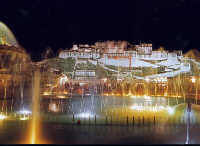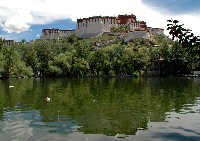|
Construction of the White and Red Palaces of the Potala Palace
( 2005-10-14 )
 Upon request by the monastic bloc of the Yellow Sect, Gushri Khan, head of the Hoshod Mongols in Xinjiang and Qinghai of Northwest China, invaded Tibet and toppled the Tsangpa Desi regime in Xigaze in the early 1640's. With support from Gushri Khan, the 5th Dalai Lama established the Gandain Phodrang regime in Lhasa, thus turning Lhasa once again into Tibet's political, cultural, and religious center. Upon request by the monastic bloc of the Yellow Sect, Gushri Khan, head of the Hoshod Mongols in Xinjiang and Qinghai of Northwest China, invaded Tibet and toppled the Tsangpa Desi regime in Xigaze in the early 1640's. With support from Gushri Khan, the 5th Dalai Lama established the Gandain Phodrang regime in Lhasa, thus turning Lhasa once again into Tibet's political, cultural, and religious center.
In 1652, when the 5th Dalai Lama went to pay homage to the Qing Emperor Shunzhi in Beijing, he was given a red-carpet welcome and the Qing (1644-1911) emperor granted him the honorific title of "the Dalai Lama," as well as a golden seal of authority and a golden sheet of confirmation. From then on, the title of the Dalai Lama as well as the Dalai Lama's temporal and religious position in Tibet were established, contributing to the closer ties between the Central Government and the local government of Tibet.
The 5th Dalai Lama pressed ahead with urban construction in Lhasa. A major project was the renovation of the Potala Palace. Exposed to thunderbolts, fire, wars, wind, and rain, the Potala Palace was a tattered sweep of ruins. The only remaining buildings were the Hall of the Goddess of Mercy and the Cave for the Prince of Dharma.
In 1645, the 5th Dalai Lama ordered the rebuilding of the Potala Palace for the Gandain Phodrang regime. Desi Soinam Raodain was put in charge of the project, and thousands of builders and artisans were recruited from all over Tibet. The main part of the Palace was renovated in 1647, and efforts began to fix the interior, re-paint the frescos, and re-make statues of Buddha.
In 1653, when the 5th Dalai Lama returned from Beijing, a grand ceremony was held for the consecration of the Palace. The 5th Dalai Lama moved from the Zhaibung Monastery to the White Palace in the Potala Palace.
The 5th Dalai Lama passed away in 1682. Desi Sangyi Gyamco hid the news from the Central Government. In 1690, he began building a holy stupa (shrine) and memorial hall for the 5th Dalai Lama, the famous Red Palace, which is larger than the White Palace in size.

The construction of the Red Palace was a momentous task. About 7,700 artisans and builders were employed every day. Qing Emperor Kangxi sent artisans of the Chinese and Mongolian ethnic groups to Lhasa to help with construction. There were also many artisans from Nepal who came to help with construction work. Huge pieces of wood came from the Gongbo area hundreds of kilometers away, and large slabs of rock were transported from mountains in the surrounding area. Cowhide rafts were used by thousands of people to cross the rapids and carry items up to the Red Palace.
When the Red Palace was completed four years later, a ceremony was held on the 20th day of the fourth Tibetan month in 1693. Sangyi Gyamco had a stone tablet (without inscriptions) erected in front of the Red Palace.
|

